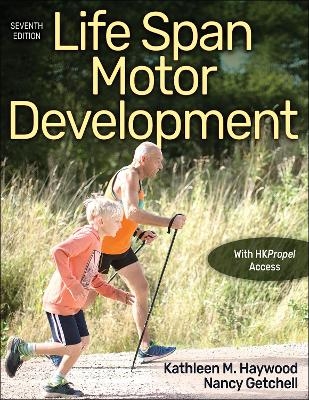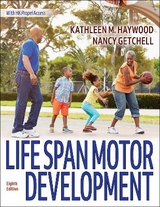
Life Span Motor Development
Human Kinetics (Verlag)
978-1-7182-1080-6 (ISBN)
- Titel erscheint in neuer Auflage
- Artikel merken
This is the loose-leaf version of Life Span Motor Development, Seventh Edition With HKPropel Access, which offers students a lower-priced printed version of the text. Other binding options are also available.
Life Span Motor Development, Seventh Edition With HKPropel Access, is a leading text for helping students examine and understand how interactions of the developing and maturing individual, the environment, and the task being performed bring about changes in a person’s movements. This model of constraints approach, combined with an unprecedented collection of video clips marking motor development milestones, facilitates an unmatched learning experience for the study of motor development across the life span.
The seventh edition expands the tradition of making the student’s experience with motor development an interactive one. Related online learning tools delivered through HKPropel include more than 190 video clips marking motor development milestones to sharpen observation techniques, with interactive questions and 47 lab activities to facilitate critical thinking and hands-on application. The lab activities may be assigned and tracked by instructors through HKPropel, along with chapter quizzes (assessments) that are automatically graded to test comprehension of critical concepts. The text also contains several updates to keep pace with the changing field:
Content related to physical growth and development of the skeletal, muscle, and adipose systems is reorganized chronologically for a more logical progression.
New material on developmental motor learning demonstrates the overlap between the disciplines of motor development and motor learning.
New insights into motor competence help explain the relationship between skill development and physical fitness.
The text helps students understand how maturational age and chronological age are distinct and how functional constraints affect motor skill development and learning. It shows how the four components of physical fitness—cardiorespiratory endurance, strength, flexibility, and body composition—interact to affect a person’s movements over the life span, and describes how relevant social, cultural, psychosocial, and cognitive influences can affect a person’s movements. This edition comes with 148 illustrations, 60 photos, and 25 tables—all in full color—to help explain concepts and to make the text more engaging for students. It also retains helpful learning aids including chapter objectives, a running glossary, key points, sidebars, and application questions throughout each chapter.
Life Span Motor Development, Seventh Edition, embraces an interactive and practical approach to illustrate the most recent research in motor development. Students will come away with a firm understanding of the concepts and how they apply to real-world situations.
Note: A code for accessing HKPropel is included with all new print books.
Kathleen M. Haywood, PhD, is professor emerita at the University of Missouri at St. Louis, where she has researched life span motor development and taught courses in motor behavior and development, sport psychology, and biomechanics. She earned her PhD in motor behavior from the University of Illinois at Urbana-Champaign in 1976. Haywood is a fellow of the National Academy of Kinesiology and the Research Consortium of the Society for Health and Physical Education (SHAPE America). She is also a recipient of SHAPE America’s Mabel Lee Award. Haywood has served as president of the North American Society for the Psychology of Sport and Physical Activity and as chairperson of the Motor Development Academy of SHAPE America. Haywood is also the coauthor of four editions of Archery: Steps to Success and of Teaching Archery: Steps to Success, published by Human Kinetics. She resides in Saint Charles, Missouri, and in her free time enjoys fitness training, tennis, and dog training. Nancy Getchell, PhD, is a professor at the University of Delaware in Newark. For nearly 30 years, Getchell has investigated developmental motor control and coordination in children with and without disabilities. Her current research focus is on brain/behavior relationships in children with developmental coordination disorder and other conditions. She teaches courses in motor development, motor control and learning, research methods, and women in sport. Getchell is currently the president of the International Motor Development Research Consortium as well as a professional member of the North American Society for the Psychology of Sport and Physical Activity, and the International Society of Motor Control. She is a research fellow of SHAPE America and has served as the chairperson of the Motor Development and Learning Academy. Currently, Getchell serves as an associate editor for Research Quarterly for Exercise and Sport and on the editorial board of Physical Education and Sport Pedagogy and Frontiers in Psychology. Getchell obtained her PhD from the University of Wisconsin at Madison in 1996 in kinesiology with a specialization in motor development. In 2001, Getchell was the recipient of the Lolas E. Halverson Young Investigator Award in motor development. Getchell resides in Wilmington, Delaware, where she enjoys hiking, geocaching, and bicycling.
Part I. Introduction to Motor Development
Chapter 1. Fundamental Concepts
Defining Motor Development
Constraints: A Model for Studying Motor Development
How Do We Know It Is Change?
A Developmental Paradox: Universality Versus Variability
Summary and Synthesis
Chapter 2. Theoretical Perspectives in Motor Development
Maturational Perspective
Information Processing Perspective
Ecological Perspective
Current Interests
Summary and Synthesis
Chapter 3. Principles of Motion and Stability
Understanding the Principles of Motion and Stability
Using the Principles of Motion and Stability to Detect and Correct Errors
Summary and Synthesis
Part II. Development of Motor Skills Across the Life Span
Chapter 4. Early Motor Development
How Do Infants Move?
Why Do Infants Move? The Purpose of Reflexes
Motor Milestones: The Pathway to Voluntary Movements
Development of Postural Control and Balance in Infancy
Summary and Synthesis
Chapter 5. Development of Human Locomotion
The First Voluntary Locomotor Efforts: Creeping and Crawling
Walking Across the Life Span
Running Across the Life Span
Other Locomotor Skills
Summary and Synthesis
Chapter 6. Development of Ballistic Skills
Overarm Throwing
Kicking
Punting
Sidearm Striking
Overarm Striking
Interventions
Summary and Synthesis
Chapter 7. Development of Manipulative Skills
Grasping and Reaching
Catching
Anticipation
Summary and Synthesis
Part III. Physical Growth and Aging
Chapter 8. Physical Growth, Maturation, and Aging
Prenatal Development
Postnatal Development
Summary and Synthesis
Chapter 9. Development and Aging of Body Systems
Systems Development During the Prenatal Period
Systems Development During Childhood and Adolescence
Systems Development During Adulthood
Summary and Synthesis
Part IV. Development of Physical Fitness
Chapter 10. Development of Cardiorespiratory Endurance
Physiological Responses to Short-Term Exercise
Physiological Responses to Prolonged Exercise
Summary and Synthesis
Chapter 11. Development of Strength and Flexibility
Muscle Mass and Strength
Development of Flexibility
Summary and Synthesis
Chapter 12. Weight Status, Fitness, and Motor Competence
A Model of Interrelationships
Body Composition
Obesity
Motor Competence, Activity, Fitness, and Body Composition
Summary and Synthesis
Part V. Perceptual-Motor Development
Chapter 13. Sensory-Perceptual Development
Visual Development
Kinesthetic Development
Auditory Development
Intermodal Perception
Summary and Synthesis
Chapter 14. Perception and Action in Development
The Role of Action in Perception
Postural Control and Balance
Summary and Synthesis
Part VI. Functional Constraints in Motor Development
Chapter 15. Social and Cultural Constraints in Motor Development
Social and Cultural Influences as Environmental Constraints
Other Sociocultural Constraints: Race, Ethnicity, and Socioeconomic Status
Summary and Synthesis
Chapter 16. Psychosocial Constraints in Motor Development
Self-Esteem
The Link Between Perceived and Actual Motor Competency
Motivation
Summary and Synthesis
Chapter 17. Developmental Motor Learning
Unpacking the Definition of “Motor Learning”
A Brief History of Developmental Motor Learning
Stages of Learning and the Development of Expertise
Practice and Motor Learning
Augmented Feedback and Motor Learning
Other Factors that Impact Motor Learning
Summary and Synthesis
Chapter 18. Conclusion: Interactions Among Constraints
Using Constraints to Enhance Learning in Physical Activity Settings
Interacting Constraints: Case Studies
Summary and Synthesis
Appendix. Skinfold, Body Mass Index, and Head Circumference Charts
| Erscheinungsdatum | 02.08.2021 |
|---|---|
| Verlagsort | Champaign, IL |
| Sprache | englisch |
| Gewicht | 1247 g |
| Themenwelt | Geisteswissenschaften ► Psychologie ► Entwicklungspsychologie |
| ISBN-10 | 1-7182-1080-9 / 1718210809 |
| ISBN-13 | 978-1-7182-1080-6 / 9781718210806 |
| Zustand | Neuware |
| Informationen gemäß Produktsicherheitsverordnung (GPSR) | |
| Haben Sie eine Frage zum Produkt? |
aus dem Bereich



